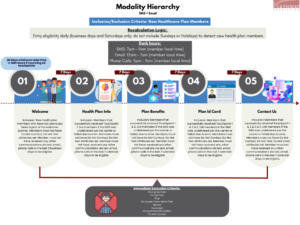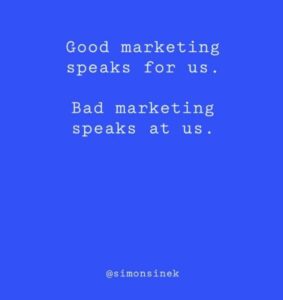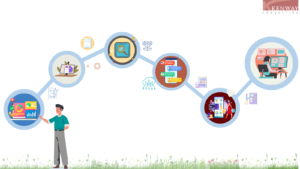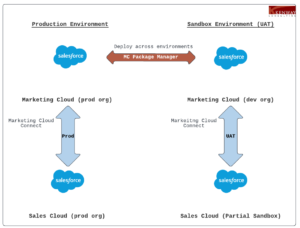Advice from the Experts: Accelerate Your Salesforce Marketing Cloud Implementation

“Good marketing speaks for us. Bad marketing speaks at us.” – Simon Sinek
This quote from Simon Sinek is meant to demonstrate the importance of knowing your customers inside out, becoming familiar with their likes and preferences and connecting with them on a uniquely personal level. But all of this relationship management takes a lot of coordination, time, and recording of details. Salesforce Marketing Cloud helps bring this to life as a Gartner Magic Quadrant leader in digital marketing and automation.
The Salesforce experts at Kenway Consulting have come to realize that the platform offers their clients an easy path for personalization at scale and thus creates deeper, more meaningful connections with their customers. And with customer needs and expectations constantly evolving in our digital age, the core of the customer journey has exposed the need to offer tailored experiences across any channel and on any device. These tailored experiences improve engagement rates with customers and allows for monetizing the life-time value of relationships. To help accelerate your Marketing Cloud implementation, our certified experts at Kenway Consulting have laid out the following recommendations to help you ensure speed and agility in your implementations.
Top 5 Ways to Optimize Your Salesforce Marketing Cloud Implementation
1. Create Your Customer Journey Map
To lay the foundation for your implementation, you should have a plan for the customer lifecycle so that you can market or engage with them based on who they are, their likes and dislikes and enabling content they want to receive. This means treating your customers uniquely at scale. This is the phase of your implementation that will help you evolve from thinking of lead generation in a silo and will cohesively bring together Sales, Marketing and Customer Service to collectively understand the customer and provide visibility for all touch points.
Here are best practices when building a Customer Journey Map in Salesforce Marketing Cloud:
- Keep journeys focused on a key objective (e.g., Welcome Journey, Surveys, Annual Wellness Journey, Explanation of Benefits). In software engineering this is known as the Single Responsibility Principle and this principle applies to customer journey design as well.
- The connected experience and plan for customers journeys does not have to be linear. Keep your plan and rules flexible and allow for nondeterministic behavior. This means that each time a customer is put into a journey, different pathways or outcomes can happen. For example, after a Welcome Journey, be flexible about what journey path a customer should participate in next based on the customer needs..
- Include all customer interactions and engagement touch points and to clearly define rules for handling channel preferences (Email, SMS, Phone Call, et. al). All channels need to seamlessly work together in the customer experience.
- Key business rules should be defined, and clear criteria should be created for segmentation rules to determine customers that qualify. Be clear with business rules where your customers may not qualify to every touch point within the journey, there may be certain messages that you skip or logic to redirect down divergent paths.
- Ensure you have a feedback loop to consider customer interactions and customer behavior to give a tailored experience. You should design and build to continually adjust based on new information.
Kenway Consulting has developed a Customer Journey Map infographic template to help expedite your design that translates nicely to Marketing Cloud implementations. Here is an example customer journey map that leverages our template to help accelerate Marketing Cloud development.

Once you have your journey roadmap created, you should devise a plan to automate the entire lifecycle of engagement along the journey. The more you automate, the more you can focus on building relationships with your customers and avoid time wasted on clerical tasks.
Often, this starts in Salesforce Sales Cloud or Service Cloud with a plan to automatically move leads or contacts into Marketing Cloud via Marketing Cloud Connect. Your automation should take full advantage of bringing in all the data necessary to drive automation and segmentation in Automation Studio via SQL. For many of our clients, this means constantly bringing in data to determine which journeys / campaigns, priority order and other attributes need to be considered to re-evaluate how to best engage with the customer. Automation continues beyond data extensions and into Journey Builder to orchestrate and automate multi-channel engagement.
Last, Journey Builder and Marketing Cloud will let you automate any event or transaction back into Salesforce. You will need a 360 view of customer interactions; not only can you sync emails back into Salesforce, but you can also create and update any records you need (Tasks, Cases, Custom Object records). This automation pattern will allow your Marketing team to focus on content, monitoring journeys, increasing engagement and ultimately improving your customer experience.
3. Develop Your Test Strategy
As you likely already know, Marketing Cloud is a completely different platform in the Salesforce ecosystem as it was acquired from Exact ten years ago. Salesforce generally offers world-class support for creating Sandboxes and Scratch Orgs to promote flexible development and testing strategies. However, Marketing Cloud does not offer standalone sandbox environments and thus you need a Test Strategy from the start.
Test strategies can range from maintaining separate “test only” data extensions, importing or manually creating test data into production data extensions (this is not recommended, but is commonly used), and leveraging Business Units to isolate test components. There are limitations for all the mentioned strategies to overcome the lack of sandboxes. There is also the option to purchase and leverage another Marketing Cloud tenant org for more complex use cases, which offers the advantage of having Marketing Cloud Connect point and sync data from a Salesforce sandbox. Having a robust testing strategy from the start will accelerate your testing cycles and will save you from critical errors and limit your reputational risk.
Sample Test Strategy with Multiple Orgs
4. Get to Know Journey Builder
If you are going to develop an end-to-end customer journey for your organization, Journey Builder is the tool in Marketing Cloud that will bring that to life and orchestrate everything. This can be as simple as a single send journey or a series of engagement touch points spanning multiple months. Journey Builder is also pivotal in multi-channel customer engagement. You can build your journey in a flexible manner so that if your customer has a preference to get email instead of SMS, you can switch them down that path and engage with your customers in the way they want to communicate with you.
Marketing Cloud gives a lot of control with automating journey entry and knowing how and when to leverage these options will save valuable time and resources during your implementation. Entry with Data Extensions and Automation Studio should be your “go-to” option for customer segmentation.
Another noteworthy entry source feature is the ability to use Salesforce Data Events which pushes contacts into the Journey in near real-time. When considering this option keep in mind this pattern is subject to Salesforce Governor Limits. The last entry source to briefly mention is API events which enables the ability to trigger real-time engagement in Journey Builder from an external system. The option to use external events via APIs gives maximum flexibility to meet customized business requirements.
The journey canvas in Journey Builder
In conjunction with Journey Builder and entry sources, you will also have to become an expert in Automation Studio as the two work together.
5. Custom Activities
Journey Builder is probably the most important and valuable tool in Marketing Cloud because it enables segmentation, orchestration and personalization at scale. While the out-of-the-box activity and action components in Journey Builder offer a great starting point, Marketing Cloud also offers the ability to create your own Custom Activities and Events. This lets you extend the functionality of Marketing Cloud in any way you see fit for your business. If you need custom logic to process in an external system via an API this is your tool set. For example, if you leverage a Direct Mailing vendor with APIs you can trigger this mail event directly from Journey Builder. Once you build your custom activity, it will be available in the Journey Builder canvas for use across any journey.
Here is the basic pattern for a Custom Activity. Please note that you will have to host your own custom JavaScript code. Salesforce recommends Heroku but any serverless cloud services will work, we most recently built for a client on AWS Lambda.
Salesforce Marketing Cloud Experts and Partners
The Kenway Consulting team acts as an extension of your team and can take your Salesforce Marketing Cloud environment to a more optimal state, helping you reach your business goals without having to do all the work solo. Connect with us to learn more about how our certified Salesforce Marketing Cloud consultants can help accelerate your Marketing Cloud implementation.














